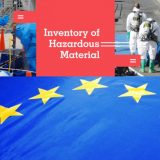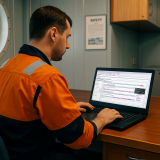Smart glasses that are powered by augmented and virtual reality (AR/VR) technologies are being used to facilitate site inspection and remote monitoring in a new pilot at Singapore’s Keppel Offshore & Marine (Keppel O&M). Running on M1’s 5G network, the project is part of a government grant to drive the commercialisation and adoption of 5G applications.
The smart glasses are can carry out real-time analyses and generate data, which the wearer can use to support his tasks. The device also allows the wearer to communicate with a control room or receiver. Each pair is equipped with a camera lens, microphone, micro speaker, and a micro projector that can project a digital overlay of text and images within the wearer’s field of vision. The glasses connect online via cellular or Wi-Fi.
The pilot is part of Keppel O&M’s efforts to tap digital and virtual technologies to improve the efficiency of remote operations for its workforce, according to a joint statement released Wednesday by the maritime player and M1. Both companies are subsidiaries under Keppel Corporation.
For example, the smart glasses will be worn by inspection personnel to view work instructions on-site as part of asset maintenance work. Controlled via voice commands, the device replaces the need for manual check sheets and drawings and also can facilitate remote coaching. It can cut manhours required for on-site quality inspection by up to 50%, Keppel said.
Other use cases tested under the pilot include remote monitoring with digital twin virtualisation, during which field engineers can capture and stream live sensor data via the AR-enabled glasses back to the main office and receive real-time remote guidance. The data also can be overlayed on-site, within the engineer’s field of vision, to display information such as the equipment’s real-time performance and condition, during operations.
It provides a common platform on which both the field engineer and office-based support staff can troubleshoot and rectify issues. This use case aims to improve field efficiency by 40%.
The smart glasses also will be tapped to facilitate remote virtual walkthroughs of a vessel, enabling Keppel engineers, customers, and classification societies–part of a wider ecosystem involved in the construction and operation of maritime structures–to carry out pre-construction feasibility assessments simultaneously. The goal here is to enable potential engineering design issues to be identified earlier and, hence, mitigate pre-construction risks.
Engineering also can use the smart glasses during the construction phase to validate the project is adhering to correct specifications. The device can further support collaboration between different shipyards and locations where various vessel components are constructed.
Keppel O&M CEO Chris Ong said the company had conducted remote inspections with the smart glasses during the height of the COVID-19 pandemic amidst limited on-site surveys and physical inspections. This now was expanded to further improve efficiencies and improve yard operations as well as deliver digital applications for its customers’ assets, Ong said.
M1 CEO Manjot Singh Mann said the smart glasses, running on a 5G network, could support high-bandwidth immersive AR/VR environments with detailed representations and real-time information to be relayed to users and control centres.
The deployment of the smart glasses at Keppel O&M could be scaled and replicated to drive operational efficiency and workplace safety for other sectors, Mann said.
The pilot is funded under Singapore’s 5G Innovation Programme, managed by Infocomm Media Development Authority (IMDA), to drive Singapore’s 5G ecosystem.
Some SG$30 million ($21.55 million) has been set aside for the scheme, which includes two other projects that will see 5G mobile edge and mixed reality (MR) technologies deployed in the healthtech sector as well as the delivery of an outdoor 5G-enabled cinematic-quality AR experience, according to IMDA.
In the healthtech initiative, IMDA and National University Health System, Singapore Telecommunications, and ApoQlar will develop 5G-enabled holomedicine, or MR capabilities that tapped holographic displays and images to enhance healthcare services. The application will leverage remote rendering technologies and MR devices such as Microsoft’s HoloLens 2, IMDA said.
“The collaboration project will enable the holomedicine platform to leverage a high-speed network, which is essential for the real-time transmission of large volumes of data from the HoloLens 2 devices,” the government agency said. “Capabilities such as real-time rendering of high-resolution 3D images and holographic projections, scan reconstructions, procedure and surgical navigation, and remote assistance will be possible in the operating theatres. Outside the operating theatres, capabilities such as enhanced visualisation of patient’s veins during blood taking procedures, advanced point-of-care ultrasound imaging capabilities, and patient education and counselling will be made possible.”
Source: https://www.zdnet.com/article/singtel-claims-95-standalone-5g-coverage-eyes-enterprise-uptake/





